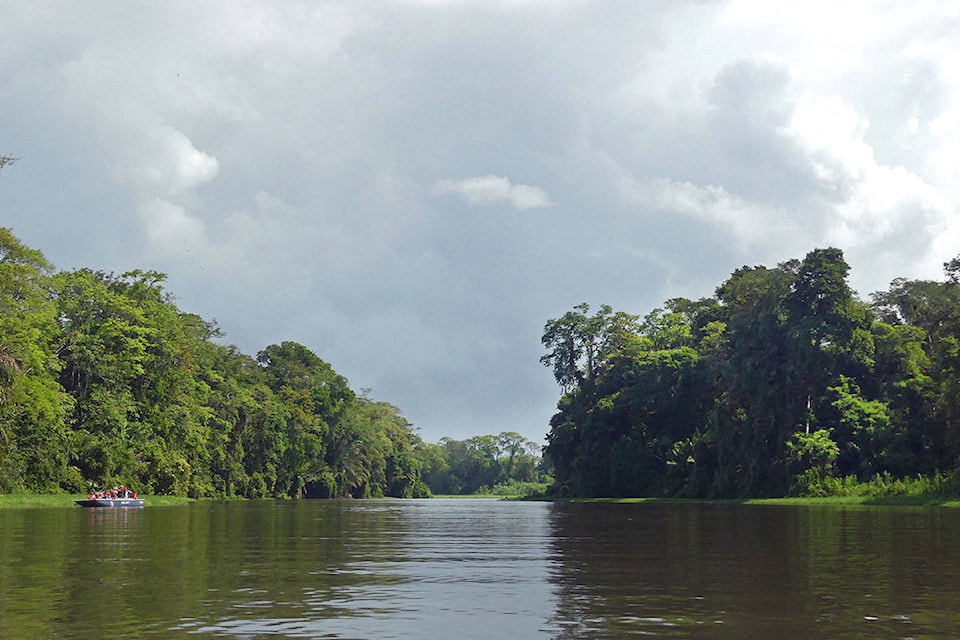BY SANDY MCRUER
Special to the News
My wife and I returned from a trip to Costa Rica a month ago. What a great trip it was! There was so much to take in. We made enyucadas, a traditional Costa Rican dish. We milked a cow and crushed sugarcane, then drank the syrup. There was a ride on a traditional oxen-driven pioneer cart, a night tour featuring armadillos , a venomous viper, tarantulas, bats, sloths and sleeping birds like Hummingbirds and a Motmot (Google that!), a tour of some ruins, and way, way more. It’s too much to tell in a small space like this. So I’ll just talk about Tortuguero, a remote small village on the Caribbean side of Costa Rica.
Tortuguero reminds me in some ways of Bamfield and Tofino. It is located near a river-mouth on the inside of a giant sand bar on a 200-mile long beach than runs from Nicaragua to southern Costa Rica. There are no roads to get to it. It is surrounded by 5,600 square kilometres of thick, impenetrable, swampy jungle stretching into Nicaragua. This huge area comprises Tortuguero National Park, and two biosphere reserves.
A boat is the only way to get to it other than landing on a small airstrip carved out of the jungle down the beach. So there are no vehicles in the town besides a few quads for emergencies. To get to any of the dozen lodges in the area from the village, you still need a boat.
The origins of Tortuguero stem from the 1930s with logging in the rainforest. Today most of the forest is secondary forest, or second-growth, as I call it. This forest is now big and protected. Consequently, it’s teeming with all kinds of creatures: spider, howler, and capuchin monkeys, sloths, agoutis and many kinds of bats. Birds too: trogons, aracaris, motmots, macaws, parrots, sungrebes, etc.
But it is sea turtles that gave the village its name and its reputation. After Costa Rica’s civil war in 1948, Costa Rica disbanded its army and used the money that was saved for social programs. In the 1950s the country was considered stable enough that American biologists felt safe enough to start various research programs. One of them, Dr. Archie Carr, discovered how important the beach at Tortuguero was for nesting sea turtles including the endangered Green Sea Turtle.
Carr was able to convince the locals, whose economy partly depended on turtle harvesting, and to convince a receptive Costa Rican government to create a conservation area and then a national park. Similar stories with other academics pushed Costa Rica into strategically choosing tourism over resource extraction.
As part of our package we took three large group tours: one around the lagoon to see monkeys, caimans, and birds: another was a nature walk, and another was to the village itself. Tortuguero has no streets. But it has alleys. The main alley contains souvenir shops, restaurants, cafes, low-end hotels and hostels—but no cash machine. It was stolen and the bank thinks it too risky to replace it.
So as most guides couldn’t take a credit card, we had to get creative to do a private tour up Tortuguero Mountain.
The tour cost eight day-tickets to Tortuguero National Park. As the park does accept credit cards, and virtually all tours are in the park, he can use these tickets for other clients. After a steep climb up to 100 metres or so on a cement staircase we enjoyed a great view of Tortuguero, the lagoons and an endless beach sweeping southward as far as you can see.
It’s only 200m or so to the outside beach, and of course it’s magnificent! However, it isn’t that flat. The ocean is pretty choppy, and there are lots of rip tides, and crocodiles, so few people swim in the water.
We were visiting Tortuguero during the low season, if you can believe it. That was a good thing. There were lots of tourists around. Lots. And so there were lots of small tourist pangas poking in to every into every little branch or caño of the lagoons. I’m not sure I would have enjoyed the scene in the high season of July and August.
Another consideration for those thinking of visiting Tortuguero is that the usual way in along the Suerte River from La Paloma has dried up so much it isn’t navigable for the boats now. Despite the village usually receiving almost five metres of rain annually, it has been very dry this winter throughout northern Costa Rica.
So, unexpectedly, we went in via a canal dug from the Parismina River from Caño Blanco to Tortuguero. Given that many of the lodges are built on stilts because of the frequency of flooding, the lack of rain has to be a source of concern for the entire economy of the town.
